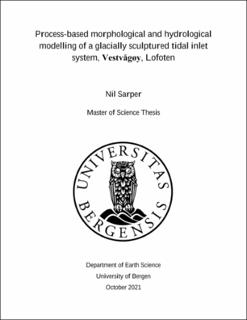| dc.description.abstract | This thesis investigates the decadal-scale morphological developments of a glacially sculptured tidal inlet system at the Lofoten archipelago in Norway. The tidal inlet system consists of three interconnected basins with small and shallow tidal inlets that allow seawater to enter the basins. The most seaward basin is connected to the sea with two channels. The easterly channel is closed off by man-made barriers. The question is what happens with the morphology and tides if those barriers are removed. The grain size analysis reveals that the study area consists of fine sand around the channels (inlets). Further, water level measurements show that tidal choking is the dominant process in the system. For example, at present, the tidal amplitude is 79% reduced in the basin closest to the sea compared to the tidal amplitude in the sea. To investigate future scenarios, a process-based hydro-morphological model is used. First, the model is calibrated on reproducing the measured tidal water levels as good as possible, using the depth and roughness as calibration parameters. Two future scenario cases are investigated with the calibrated model. The first scenario represents a continuation of the present situation 10 years into the future, where one of the channels is closed with man-made barriers (T1), while the second scenario represents a future state where the barriers are removed (T2). In T1, the bed level changes are limited. Removal of the barriers in scenario T2 causes rapid erosion of the eastern channel (~months-few years). Large erosion of the eastern channel causes the tidal wave to penetrate more into the system. Tidal choking is reduced from 79% in T1 to 29% in T2 in the first basin. In this case, the bedrock is assumed at -3 m in the eastern channel. The erosion is only limited by the unknown depth of the bedrock of the easterly channel. This is also the largest uncertainty of the model. The question is not if the channel will erode in scenario T2, but how much. Measuring the bedrock as a future work can greatly contribute to more accuracy of the results. The system is expected to be (more) inundated in the future due to the expected sea-level rise. This would give similar conditions as the Viking age. | |
